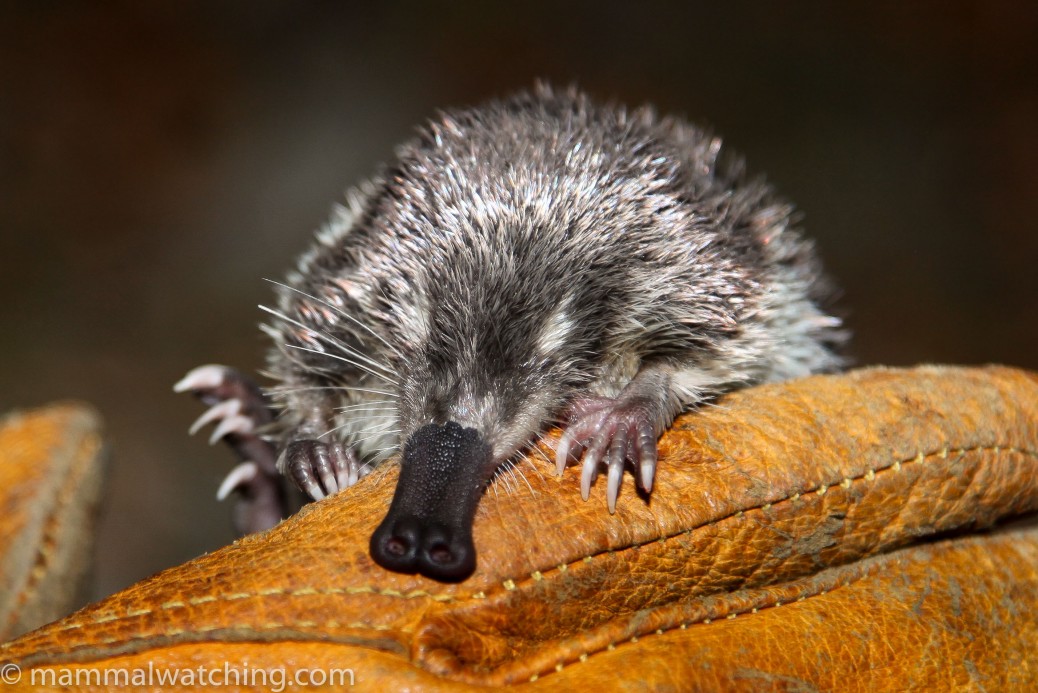
Spain and the Canary Islands
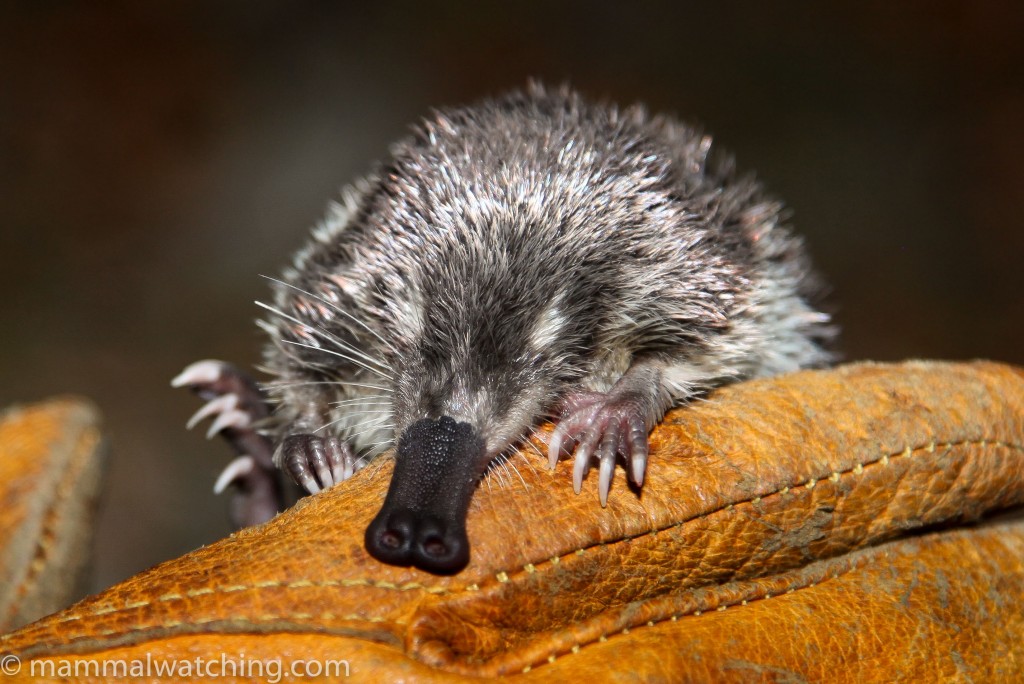
Pyrenean Desman, Galemys pyrenaicus
I have been to Spain several times and it is one of my favourite countries in Europe: for the mammals, the food and the people.
Andalusia
Andújar
Until the mid 2000s I thought that the Cota Donana National Park in Spain was the only place that offered any chance of seeing the Iberian (or Pardel) Lynx. Even here they were not easy to find. But then I began to hear about a site near Andújar in Andalusia, where Lynxes were reliably seen. I visited for a weekend in June 2008, though I was told that March through May is the best time to look for Lynxes.
Andújar is two hours’ drive north-west of Granada and about an hour north-west of Jaen. I stayed at the Los Pinos hotel, which is the closest accommodation to the lynx area and 14km north of Andújar along the road to Los Vinas. The restaurant is good and very busy until late, especially at the weekend (I am always surprised in Spain to see families with small children rocking up at midnight to sit down to dinner). But the hotel itself was quiet, comfortable and cheap. They are also Lynx-obsessed and there was no shortage of advice from the manager and the guys in the bar on where to look.
There are several good areas Lynx spotting and more recent trip reports will give the latest information. I focused my efforts on two: a lookout over the Rio Jandula, and a quiet back road north-east of Los Pinos.
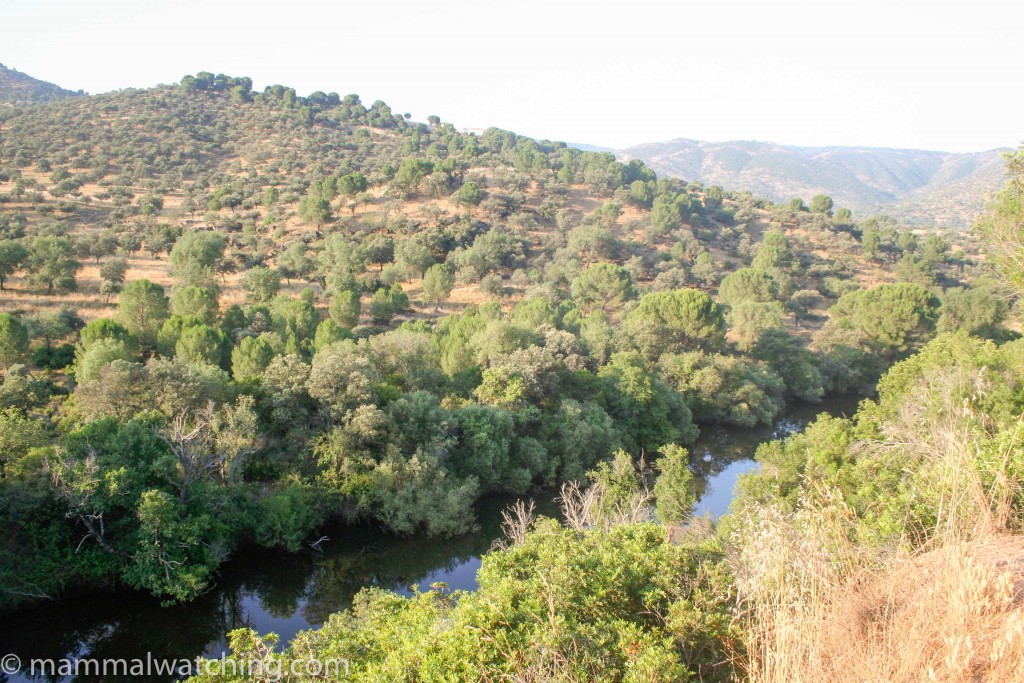
Rio Jandula site
Site 1: Rio Jandula
This spot is about 10 minutes further along the A6177 from Los Pinos heading north. At about the 22km post there is a roundabout. Go straight across, cross the river on a single lane bridge and immediately to your right is a track that runs along the river and past several picnic areas. After about 500 m the road rises and at the crest of the small hill you will see some concrete blocks on the right hand side of the track that act as a crash barrier.
This is the vantage point recommended by Richard Webb. I met a guy from the National Park here one evening who also confirmed it was good for Lynx watching. The animals often come down to the river to drink in the early morning and evening. Two days running I spent several hours here at dawn and dusk.
You can see a good slab of country from the lookout, and apart from regularly scanning with binoculars I also listened for bird alarm calls. When Richard saw a Lynx coming down to drink it was being mobbed by magpies. But I was unlucky. I did however see many Red Deer, not quite so many Fallow Deer and several sounders of Wild Boar.
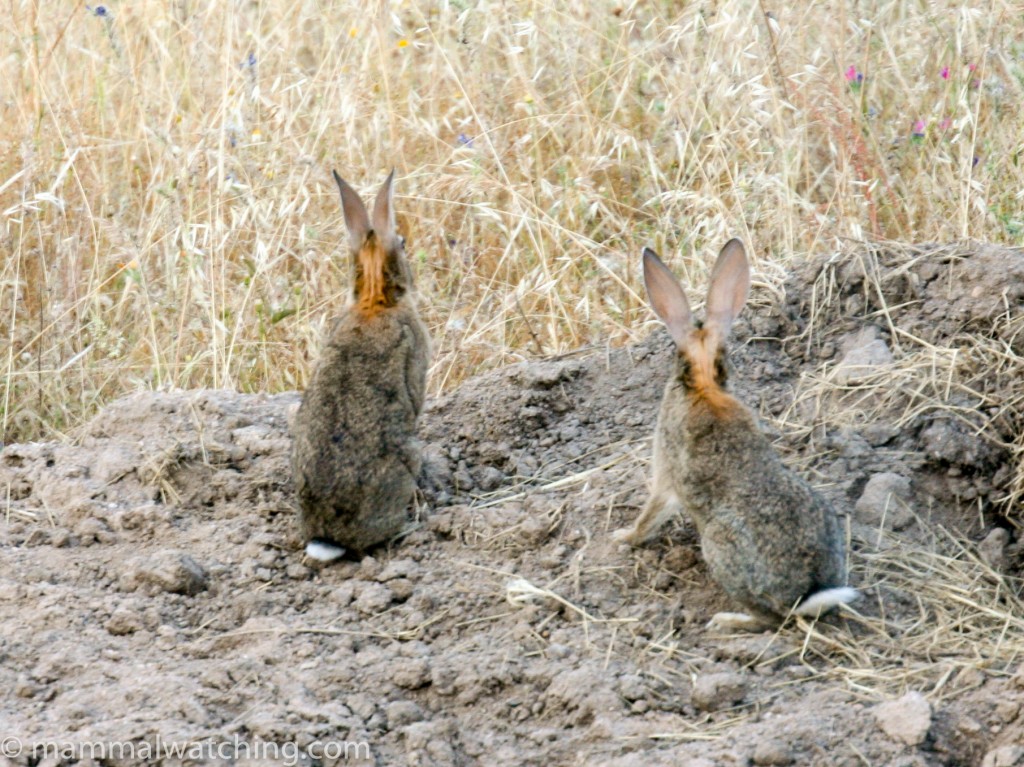
European Rabbits, Oryctolagus cuniculus
A small hill close by that overlooks the reservoir is another good vantage point. A few hundred metres further along the road from the Rio Jandula site you come to a dam wall. Park at the base of the wall and climb a small hill to your left. Phil Telfer saw an animal (or animals) several times from up there. I spent a couple of hours here but decided that there was little to chose between here and the other site, and decided to stick with the one spot.
I spent 40 minutes spotlighting around this area and saw a couple of Rabbits, some Wild Boar and what may well have been a Wild Cat crossing the road.
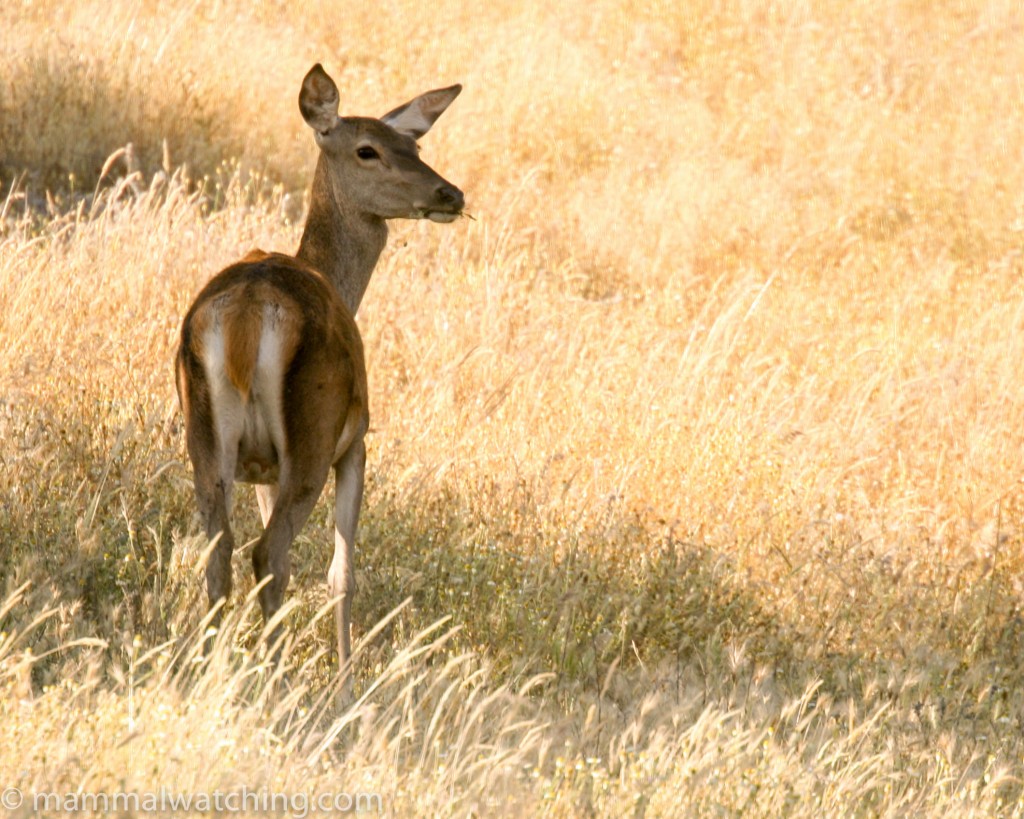
Red Deer, Cervus elaphus
Site 2: The Road to La Lancha
Take the first turn on the right after Los Pinos. The JH5001 road winds past cattle properties for about 8 km until a well signposted farm “Los Escoriales”, after which a small road goes off to the left eventually reach the top of a damn wall at La Lancha. The manager of the Los Pinos hotel recommended the middle of this stretch of road (Los Escoriales to La Lancha) as a good spot to look.
I drove the road a few times in the early morning and early evening and spotlit along it once. Red and Fallow Deer were very common and Moufflon were also common at night, including one group of about 30 animals. I also saw a couple of Red Foxes and several Rabbits . During my spotlight session I saw an Iberian Lynx on the road at 1.30 a.m. It was carrying a rabbit and I saw it only for a couple of seconds before it jumped off the road and up the hill. I carried on driving and found it back on the road again. It jumped into the bush and disappeared. I drove on, saw it on the road again, lost it, found it again on the road before finally losing it. Unfortunately none of the sightings was particularly good nor allowed time for photos.
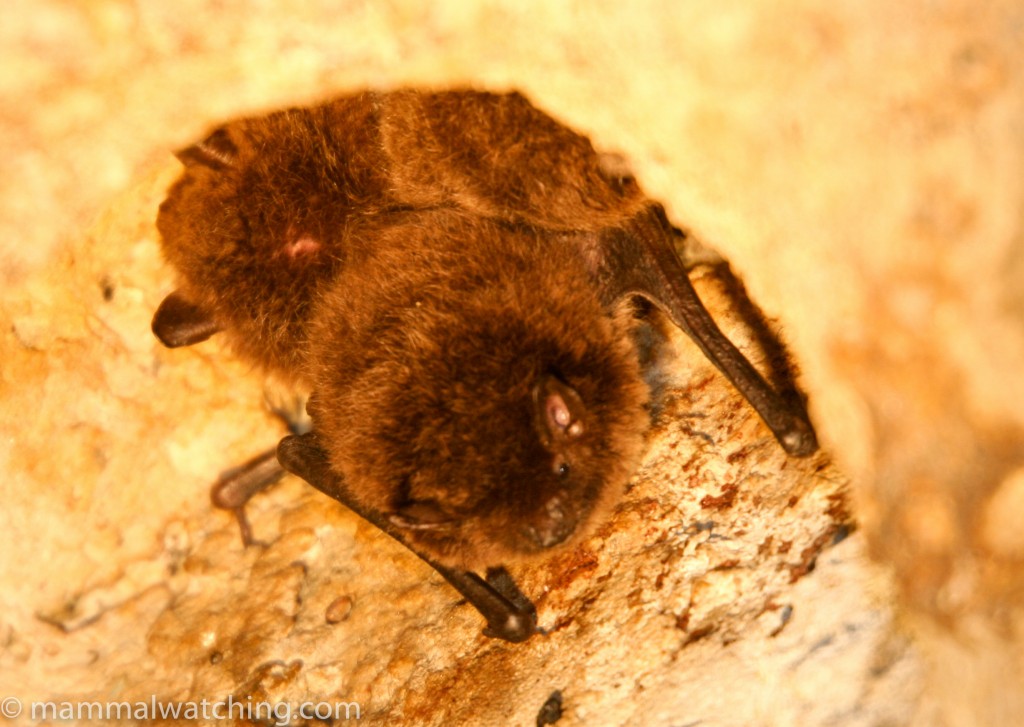
Geoffroy’s Bats, Myotis emarginatus
I set 10 live mammal traps along the road side near Los Pinos and caught my first Garden Dormouse, in some rocky scrub. It escaped before I could get my camera out.
Granada
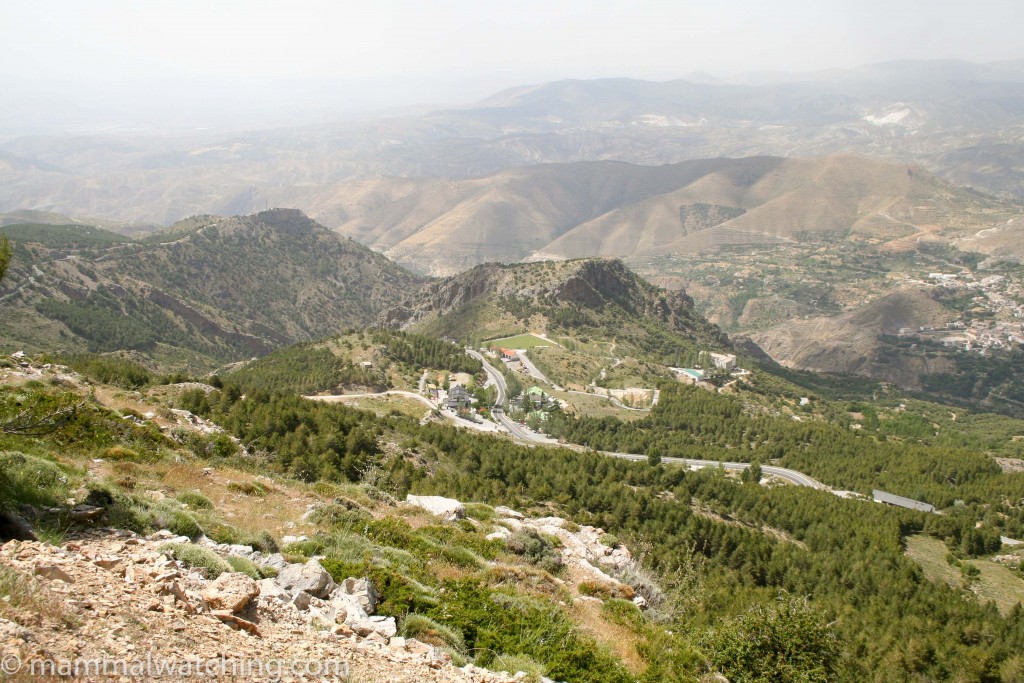
Sierra Nevada National Park
Back in Granada in 2008 I had an afternoon to spare, so I headed up to the Sierra Nevada along the A395 out of town. Spanish Ibex are common in the higher reaches of the park and though much more easily seen in the early morning and late afternoon I saw several during the mid-afternoon without too much trouble.
Stuff I Missed
Other species I might have seen included Egyptian Mongooses (reported around Andujar occasionally – Jan Kelchtermans tells me you should drive up to the monastry and then towards El Neuvo Mirador, and they often cross the road around the 12 KM mark). Otters are seen quite often in the Rio Jandula and Iberian Hares are around too (Richard Webb saw one between Los Escoriales and La Lancha at night). Phil Telfer saw a Polecat on the road between Seville and Andujar. And I suppose Wolves are also a possibility but a long shot.
My thanks to Richard Webb and Phil Telfer for some great advice when I planned this trip.
Aragon
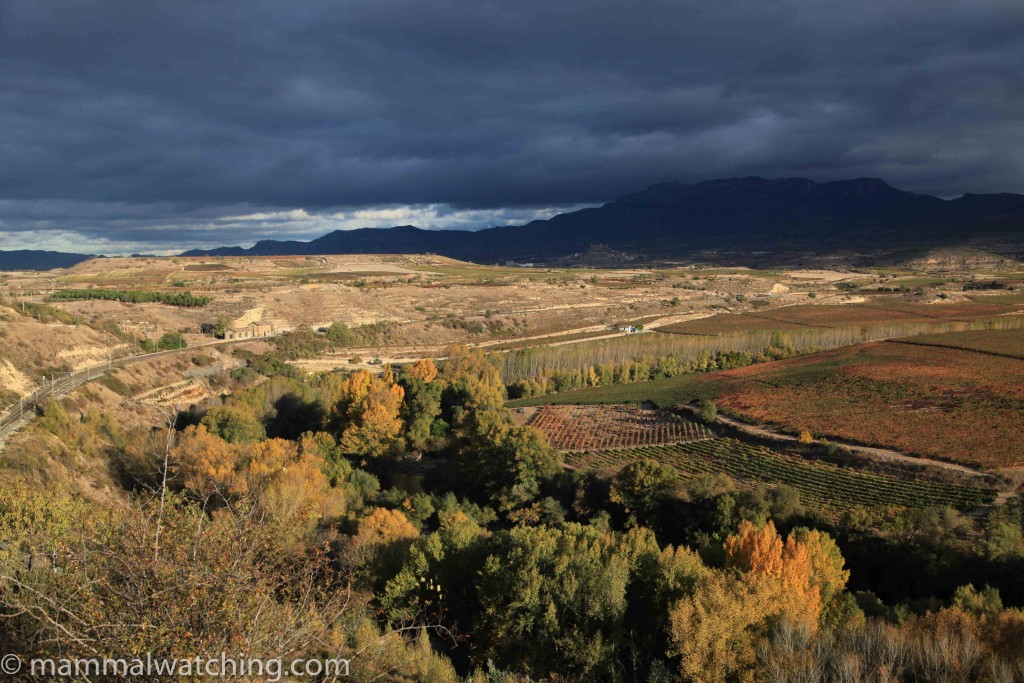
The Ebro Valley
I’d visited Hiumaa Island in Estonia twice looking for – but failing to see – European Mink. I missed the Mink but the contacts I made there were kind enough to arrange for me to tag along in October 2011 for some trapping in Spain that was part of a conservation project. Not only were Mink possible but so were Pyrenean Desman, some parallel trapping was underway for that species too which was high on my most wanted list. The scientists working on both highly endangered species are understandably sensitive about me giving too many details about where I saw them so this is just a brief report.
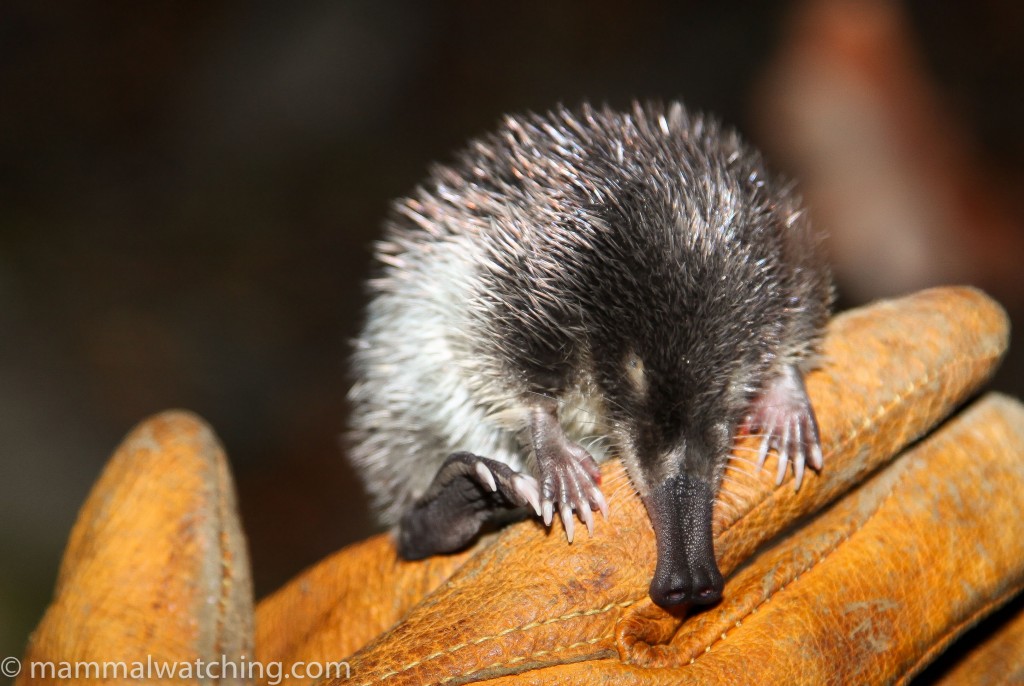
Pyrenean Desman, Galemys pyrenaicus
I’d planned to arrive in the valley on a Saturday after driving from the South of France. Unfortunately the Friday was the last night of Desman trapping . So….. I left Paris at lunchtime, took a train to the south of France, collected my kids after school and then drove 7 hours to my friends’ house. They were kind enough to let us stay at their place and also for me to leave the kids there. I arrived at 1 a.m., put the kids to bed, grabbed 20 minutes’ sleep and drove an hour into the mountains. The research team were checking the Desman traps every 3 hours. They had caught nothing at midnight but amazingly there was an animal in the first trap we checked at 3 a.m. What a fantastic critter. After a brief photo opportunity, and a DNA sample, it was released and swam at impressive speed down the stream. By 5 a.m. I was driving back to get some sleep stopping briefly to look at a Beech Marten. Woof!
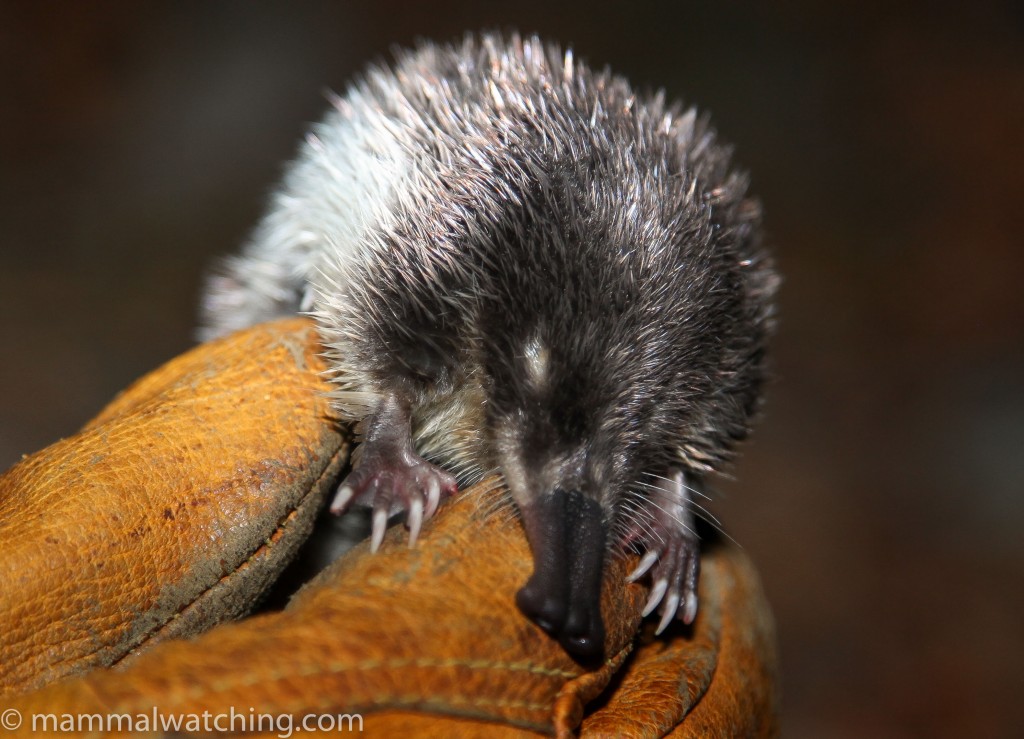
Pyrenean Desman, Galemys pyrenaicus
The Ebro valley is dry, full of vineyards and surrounded by mountains. The mountains form a barrier to incoming American Mink, which is probably why the area is a last stronghold of European Minks. Unfortunately American Minks are starting to arrive and one has to wonder how long the couple of hundred European Minks left here have left. We spent Sunday morning checking the 39 traps that had been put out. A few animals had been caught over the past 10 days (the success rate there is something like 1 animal per 100 trap nights) and there was just one in a trap that day. We took it to the vet for a check up and released it. A beautiful animal with a very bleak future.
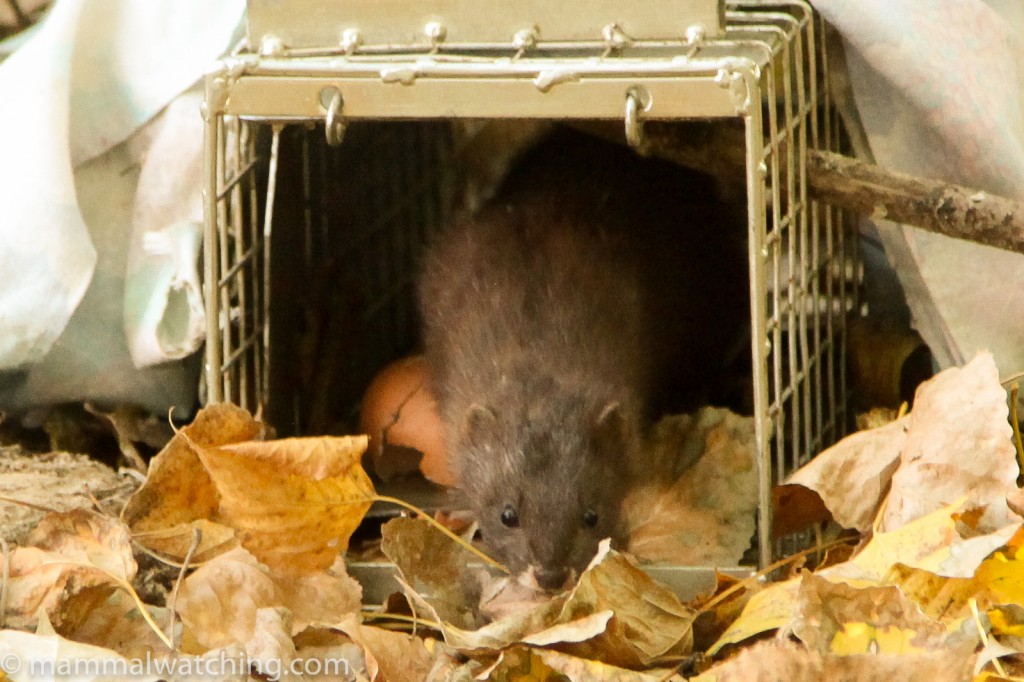
European Mink, Mustela lutreola
Asturias
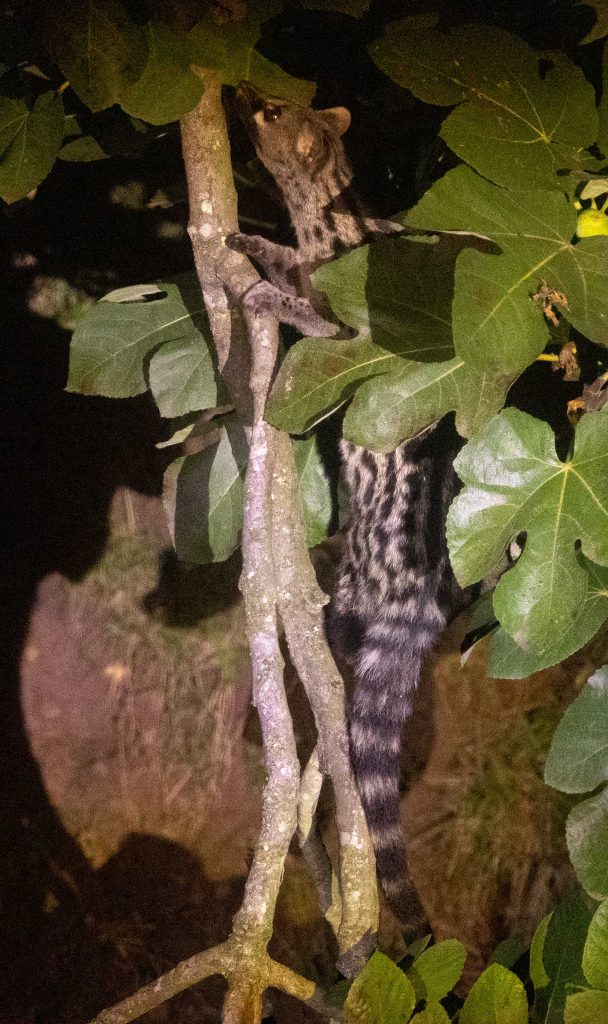
Common Genet, Genetta genetta
In September 2022 I took part in the first mammalwatching meeting. We stayed in the lovely village of Villanueva and in-between discussing the future of mammalwatching saw a bunch of nice mammals: Brown Bear, Common Genet, Broom Hare, Eurasian Otter, West European Hedgehog, Wild Boar, Red Deer, Chamois and a water vole sp that we watched being dug up and eaten by a bear.
Bay of Biscay
During the late 1990s the Bay of Biscay emerged as one of the world’s best cetacean viewing areas. The ferries than run from Portsmouth in the UK to Bilbao in Spain spend the last third of their journey running along deep canyons that are teeming with sea monsters in the summer. II took the trip once in August 1998. In the first 12 hours returning from Spain to the UK I saw False Killer Whales (unusual), many Fin Whales, many Long-finned Pilot Whales, many Striped Dolphins, an Orca, a couple of Northern Bottle nosed Whales and a Cuvier’s Beaked Whale (that cruised right past the ferry). And that is by no means an unusual trip. The ferry timetable used to leave Bilbao in the early morning but as of now (2016) it leaves in the evening and so while the cetaceans may remain, the chance of seeing them from the ferry has gone.
Castille & Leon
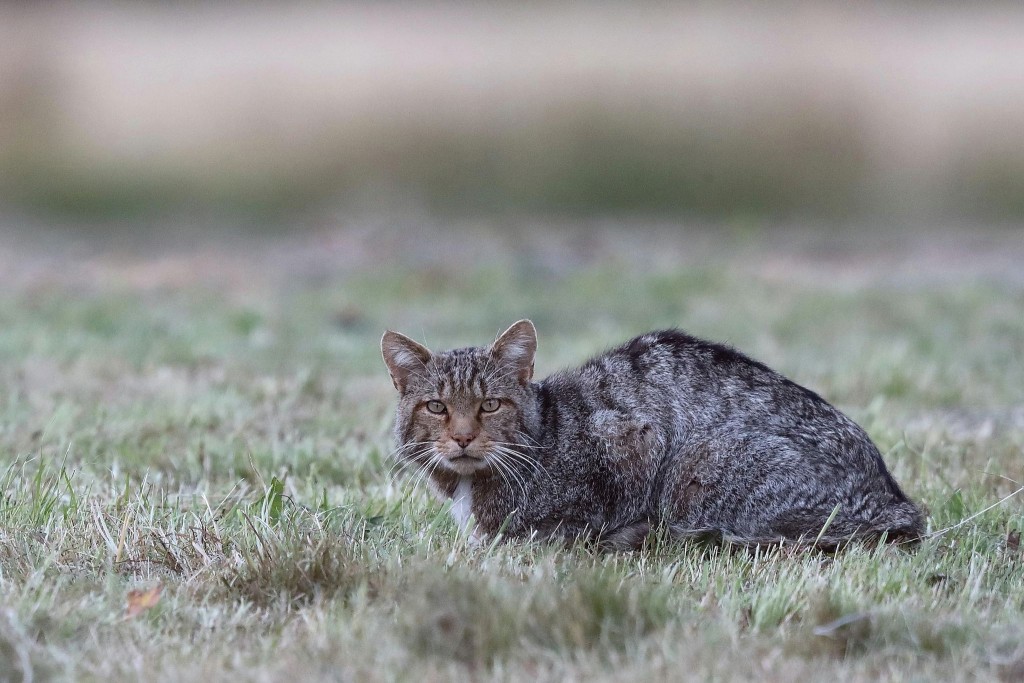
European Wildcat, Felis sylvestris. Photo Carlos Bocos.
In September 2020 I spent couple of days with Carlos Bocos in the beautiful Picos de Europa mountains based in the town of Cervera de Pisuerga. Our focus was European Wildcat and we saw two here quite easily. We also saw European Water Vole (now lumped with Montane Water Voles), the locally endemic Broom Hare, Red Deer, Red Fox and a Roe Deer.
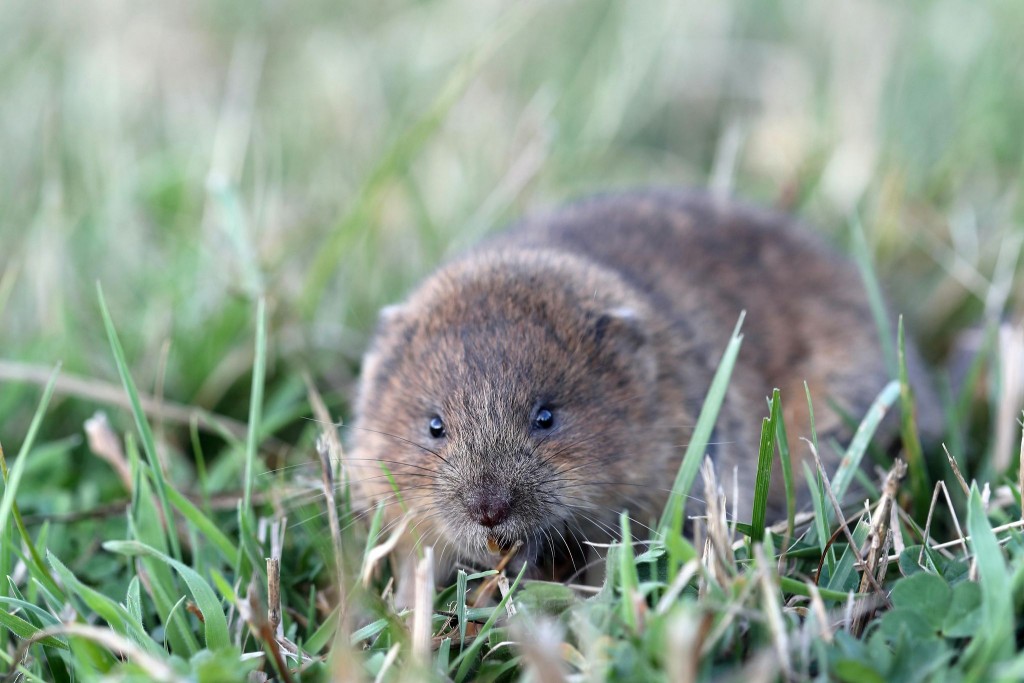
European (Montane) Water Vole, Arvicola (monticola) amphibius. Photo Carlos Bocos.
In July 2020 I was driving from Bordeaux to Madrid and wanted to look for an Iberian (Granada) Hare. I had no flashlight, binoculars or even a camera so needed a spot where one might run across the road in front of me. Carlos Bocos recommended I drive around agricultural land around Valladolid and after an hour’s search after sunset I saw one here. The area around Duraton Canyon, near Sepeulveda, was also recommended as a reliable spot for this species.
Gibraltar
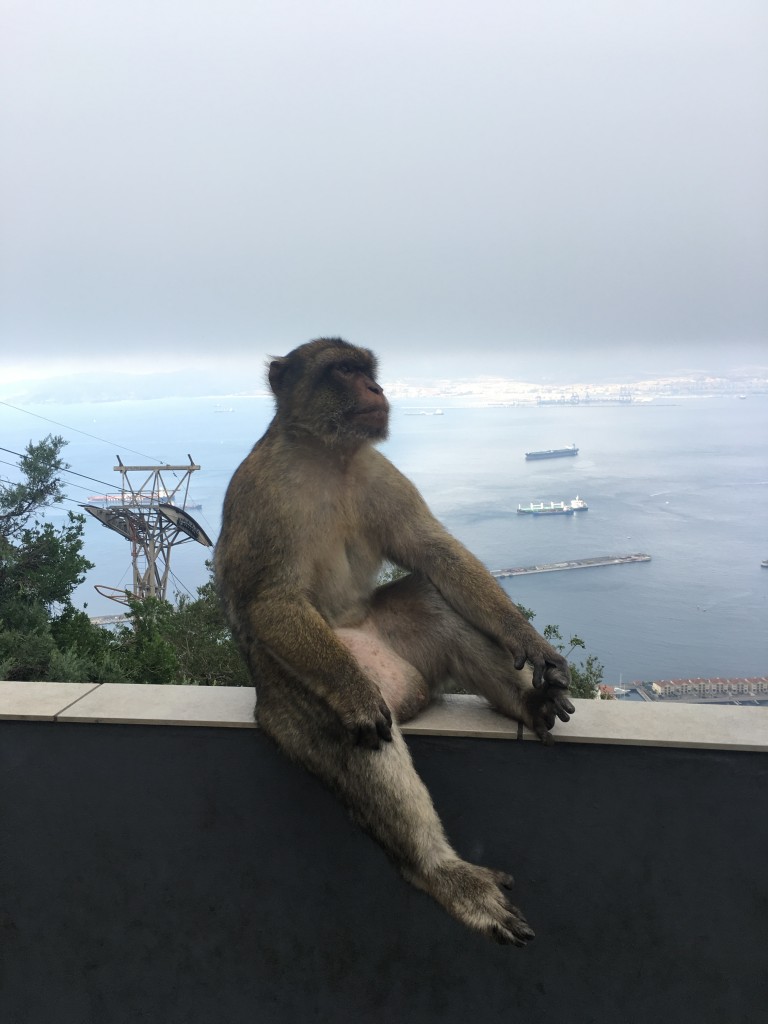
Barbary Macaque, Macaca sylvanus
Technically not Spain, but – biologically – its a lot more Spanish than British. I stopped for a few hours in this peculiar city. The introduced Barbary Macaques were easy to see at the top of the cable car. I saw a couple in the city centre too.
Community Reports
Northern Spain, 2024: Ralf Burglin, 2 weeks with species including Broom Hare, Eurasian Water Shrew and Common Genet.
Iberian Lynx (plus data to maximise your chances), 2024: Daan Drukker’s interesting report with data to maximise your lynx spotting changes, plus 13 speciesover 4 days including Iberian Lynx, Iberian Hare and Greater Mouse-eared Bat.
Northern Spain, 2023: Ben Balmford, 3 days & 14 species including Broom Hare, Wolf, Bear and Snow Vole.
Bears in the Cantabrian Mountains, 2023: Europe’s Big5 report of drama filled bear watching.
Iberian Lynx Extravaganza, 2023: Jan Kelchtermans, 1 week & 9 Lynxes.
Southern France, Spain & Gibraltar, 2023: Lorenz Achtnich, 19 days & 17 mammal species including Iberian Lynx, Eurasian Otter, Iberian Hare & Schreibers‘ Long-fingered Bat.
Spain, 2023: Janco van Gelderen, 6 days & 9 species including 8Iberian Lynxes, Otter and Iberian Ibex.
Andujar, 2023: Chris D, 3 days & species including Ibex, Mouflon, Otter and Iberian Lynx.
Iberian Lynx Tour, 2022: Cat Expeditions, 7 days & 4 species including some exceptional Iberian Lynx watching.
Spain 2022: Felis’s account of mammalwatching before, during and after the 2022 mammalwatching meeting. 11 days & 27 species including Brown Bear, Wolf and Broom Hare.
Spain and Andorra, 2022: Andreas Jonsson, 1 week & 11 species including European Wildcat, Iberian Ibex and Moufflon.
How Not to See a Desman, Catalonia, 2022: Jan Ebr’s report on an unsuccessful search for Desman, with Stone Marten the best of the bycatch mammals.
Andújar, 2022: Lonnie Bregman’s useful report of a very successful Iberian Lynx search: 3 days & 10 species including Iberian Lynx, Otter and Garden Dormouse.
Tenerife, Gran Canaria & Fuerteventura, 2022; Valentin Moser, 12 days & 9 species including Eden’s Whale, Madeira Pipistrelle and North African Hedgehog.
The Cantabrian Mountains, 2021: Carlos Bocos, 48 hours & 15 species including European Snow Vole, Broom Hare and Crowned Shrew.
Wildcats in Northern Spain, 2021: Justin Brown’s report of seeing Wildcats and Badgers.
Wildcats in the Picos de Europa, 2020: Jon Hall, 2 nights & 6 species including Wildcats, Montane Water Vole and Broom Hare.
Spain, 2020: Samuel Marlin, 3 weeks & 18 species including Brown Bear, Wolf, Genet and Cuvier’s Beaked Whale.
Sierra de Andujar, 2020: John Weir, 4 nights & 8 species including Iberian Lynx.
Spain, 2020: Wise Birding, 5 days & 5 species including Iberian Lynx.
Spain and Portugal, Christmas 2019: Vladimir Dinets, 2 weeks & 31 species including Polecat, Genet and Snow Vole.
Spain, 2018: Valentin Moser, 11 days & 13 species including Iberian Lynx, Iberian Hare and Egyptian Mongoose.
Andujar, 2018: Wise Birding, 5 days & 8 species including Iberian Lynx and Spanish Ibex.
Andujar, 2018: Lennart Verheuvel, 3 days & several species including Iberian Lynx.
Spain in winter, 2018: Adam Wentworth, 1 week & 6 species including Wolves and Iberian Hares.
Andujar and the Cantabrian Mountains, 2016: Sjef Ollers, 2 short trips with mammals including Iberian Lynx & Iberian Hare at Andujar, and Wildcat, Bear, Wolf and Broom Hare in the Cantabrian mountains.
Northern Spain, 2017: Matt and Maureen Steer, 4 days & 9 species including Wild Cat, Wolf and Pyrenean Chamois.
Spain and France, 2017: Ben Schwienhart’s notes of a few mammals including a seemingly reliable site for Pyrenean Desman.
Sierra de Andùjar, 2017: Mike Hoit, 2 days & 16 species including Iberian Lynx, Iberian Hare and European Free-tailed Bats.
Spain, 2017: John Wright, 1 week & 11 species including Otter, Schreiber’s Bat and Spanish Lynx.
Spain, 2015 & 16: Janco van Gelderen, accounts of two trips with 12 species including Egyptian Mongoose and Iberian Lynx.
Spain, 2015: Europe’s Big 5, 1 week & Bears, Wolves and Wildcats.
Picos de Europa, 2015: Janco van Gelderen, a short trip with 3 Wolves and 10 Wildcats, Red Foxes and Red Deer.
Cantabria, 2015: Wisebirding, 5 days & 6 species including Wildcat and Wolf.
North-East Spain, 2015: Richard Webb, 4 days birding with mammals including Pyrenean Chamois and Alpine Marmot.
Spain, 2014: Europe’s Big 5, 1 week & species including Brown Bear, Wildcat and Wolves.
Andalusia, 2014: Ralf Bürglin, 4 days & 8 species including Iberian Lynx, Ibex and Otter.
France & Spain, 2014: Mike Richardson, 2 weeks & 20 species including (in Spain) Brown Bear and Wild Cats.
France, Andorra, Spain & Gibraltar, 2014: Vladimir Dinets, 1 month & 65 species including Cabrera’s and Mediterranean Pine Voles, Iberian Lynx, Iberian Hare and European Polecat.
Andujar, 2013: Simon Feys, 1 week & 14 species including Iberian Lynx, Iberian Hare and an Algerian Mouse.
Spain, 2013: Coke Smith & 19 species including Iberian Lynx, Iberian Hare and a Common Genet.
Spain, 2013: Sjef Ollers, 10 days & 12 species including Iberian Lynx, Iberian Hare and Iberian Ibex.
Spain, 2013: Jan Kelchtermans & Karl Van Ginderdeuren, 2 weeks with species including Wolf, Brown Bear and Iberian Lynx. See Karl’s blog too for more pictures.
Spain, 2013: Mike Richardson, 3 days & 7 species including Wolf and Iberian Hare.
Spain, 2012: Stefanie Lahaye, 2 weeks & 26 species including Iberian Lynx, Common Genet and Egyptian Mongoose.
Iberian Lynx trip, 2012: John Wright, 3 days & several mammals including Lynx and Iberian Hares.
Andalucian Lynx and Mega Mammals of the Med, 2010 : Mark Hows, 1 week and 21 species including the Lynx.
Sierra de Andjuar, 2010: Lee Dingain, 4 days and 7 species including the Lynx. Lots of very useful detail in this report.
Spain & Gibraltar, 2009: Gina Nichol and Tom, Harry & Steve Bird, 3 weeks and 24 mammals including Iberian Lynx, Wolves and Orcas.
Sierra de Andujar, 2009: Steve Davis, 4 nights and 12 mammals including Iberian Lynx.
Sierra de Andujar, 2008: Richard Webb, 3 days and 9 mammals including Iberian Lynx.
Biscay, 2004: Mark Hows, return crossing & 6 cetaceans.
Also See
Bat ID from La Lancha Tunnel (Andujar), January 2024
RFI Andujar in October plus guides, August 2023
Iberian Ibex in Gredos near Madrid, June 2023
RFI Andujar logistics Feb 2022
RFI Iberian Ibex sites, July 2021
Spanish Mammal Posters, June 2020
RFI Lynx in Andjuar, February 2020
RFI Iberian Lynx in Donana, February 2019
True’s Beaked Whale, Bay of Biscay, July 2018
Seeing Wolves and Bears in Northern Spain: an RFI, July 2017
Bat ID from La Lancha Tunnel (near Andujar), May 2017
Wolves in Spain – RFI, September 2016
RFI For Some European Species with information on Ibex, Chamois and Moufflon, April 2013
Iberian Wild Boar and other mammals on camera near Valencia, May 2012
RFI – mammals in France and Spain, Sep 2011
Resources
Iberianature is the “principal English language source of information on the net on the nature of Spain”


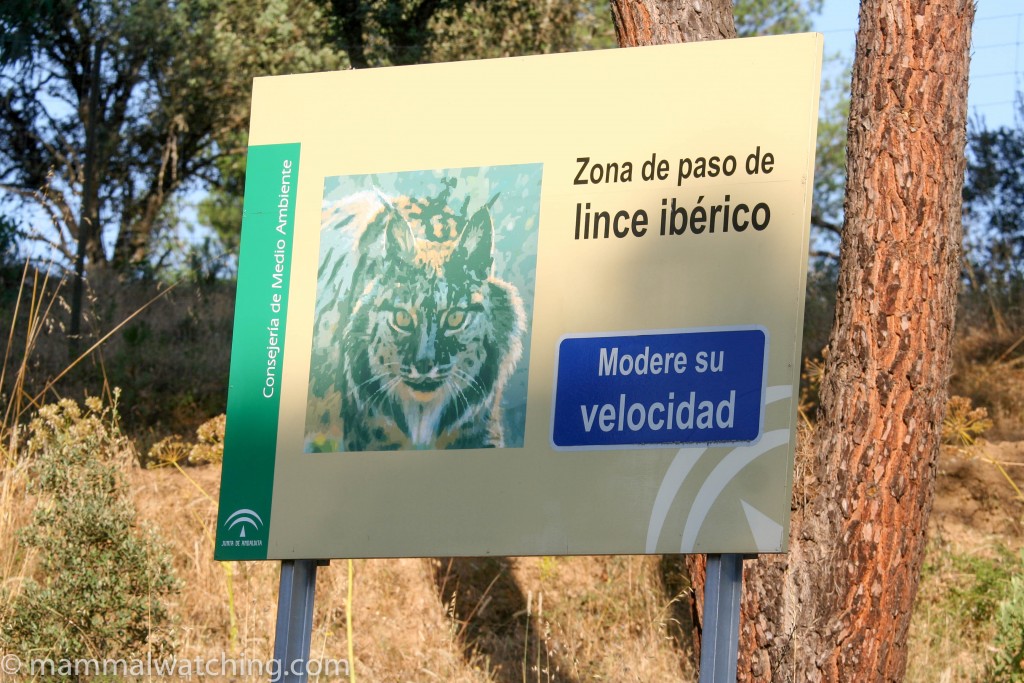
Leave a Reply
You must be logged in to post a comment.